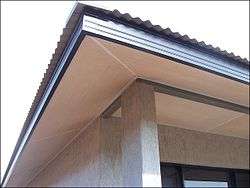Fascia (architecture)

Fascia (/ˈfeɪʃə/) is an architectural term for a vertical frieze or band under a roof edge, or which forms the outer surface of a cornice, visible to an observer. [1]
Typically consisting of a wooden board, upvc or non-corrosive sheet metal, many of the non-domestic fascias made of stone form an ornately carved or pieced together cornice in which case the term fascia is rarely used.
The word fascia derives from Latin "fascia" meaning "band, bandage, ribbon, swathe". The term is also used, although less commonly, for other such band-like surfaces like a wide, flat trim strip around a doorway, different and separate from the wall surface.
The horizontal "fascia board" which caps the end of rafters outside a building may be used to hold the rain gutter. The finished surface below the fascia and rafters is called the soffit or eave.
In classical architecture, the fascia is the plain, wide band across the bottom of the entablature, directly above the columns. The "guttae" or drip edge was mounted on the fascia in the Doric order, below the triglyph.
See also
- Eaves, a roof projection beyond the line of a building
- Soffit, the surface or surfaces, often structural under a roof projection. Term used in other structures such as for the underside of an arch.
References
- ↑ "Understanding Fascia and Soffit Repair". AngiesList.com. 2015. Retrieved 12 October 2015.